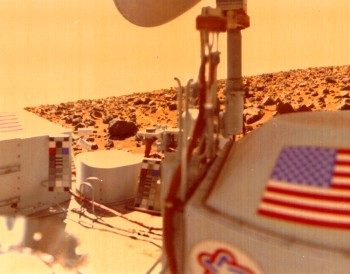Mars
Viking was the first (and only) mission to have landed a seismometer on Mars
In 1975, NASA launched an armada to Mars. No fewer than four sophisticated spacecraft (two orbiters and two landers) headed off to the Red Planet. The Viking mission, as it was known, revolutionized our vision of Mars for several decades and even today is one of the most spectacular programmes ever undertaken by NASA, the US space agency.
The Viking spacecraft, and more especially the landers, were designed to look for signs of life on Mars, and the mission therefore focused on exobiology. However, geophysicists managed to edge in on the mission, and each of the two ground stations contained a seismometer.
However, the geophysicists had to comply with several requirements and some of the resulting trade-offs had a significant impact on the seismic experiments. The seismometers, for example, were attached to the lander deck, and could not be deployed on the ground. The necessary contact with the Martian surface was through the lander legs, fitted with shock absorbers, which was far from ideal when seeking to record seismic waves travelling from the ground to the instrument.
Each seismometer had a mass of 2.2 kg and consumed about 3.5 watts. Sensitive to short-period waves in all three directions, the Viking lander seismometers were about 10 times less sensitive (of the order of a nanometre) than those deployed on the Moon during the Apollo missions. Furthermore, because of the slow data rate between the Earth and Mars, the seismic recordings had to be compressed before transmission to Earth, thus further reducing performance.
On 20 July 1976, for the first time in the history of Martian exploration, the Viking 1 spacecraft gently landed on Mars’ rust-red surface. Regrettably, the seismometer’s mechanical unlocking system failed to work, making the instrument unusable.
Being extremely sensitive to vibrations, seismometers must be protected during the mission phases when the spacecraft suffers major shaking or shocks, such as during lift-off or landing. In the case of the Viking seismometers, the moving part was mechanically locked in place so as to avoid any damage or other incidents. Unfortunately, once landed, the engineers could not manage to free the moving mass from its prison. The Viking 1 seismometer was the only inoperable instrument of the Viking mission. All the others—whether aboard the orbiters or landers—operated without a hitch.
The rapid loss of the first seismometer made the deployment of the instrument flown on the Viking 2 lander even more critical. Fortunately, after a successful touchdown on 3 September 1976 on the Utopia plain, the unlocking system worked the first time, freeing the instrument to acquire seismic data. However, geophysicists were confronted with another nasty surprise.
Riveted to the lander deck and imperfectly linked (or “coupled” in the language of geophysicists) to the ground via the lander legs, the instrument faithfully recorded events that had nothing to do with planetary tremors.
The sometimes intense activity on the lander’s deck often prevented the instrument from recording the Red Planet’s seismic life. The seismometer reacted to everything, from the rotation of a high-gain antenna or cameras to the movement of the robotic arm or even the clicks of the tape recorder when recording data. Even worse, because of its unpredictable nature, the slightest gust of wind made the spacecraft platform vibrate, which was again picked up by the seismometer’s mobile mass.
During the day, the interfering background noise due to airflow over the Viking lander was enough to prevent any good seismic measurements. The seismometer on the Viking 2 lander actually became a good weather station throughout its period of operation, i.e. 560 Martian solar days (known as “sols”), or 19 Earth months, from 1976 to 1978. The instrument did an excellent job complementing the space probe’s meteorological station, transmitting numerous data on winds and atmospheric circulation that meteorologists enthusiastically exploited. So, to adapt a well-known saying, a geophysicist’s loss can sometimes be a meteorologist’s gain.
At night, from midnight to around six o’clock in the morning, the winds dropped and the ambient quiet around the landing site nonetheless allowed geophysicists to collect a few data. However, their analysis proved very disappointing because the Viking seismometer was not as sensitive as hoped and the influence of the lander vibrations could not be estimated or cancelled out.
Even today, although Viking 2 data have been reanalysed with more sophisticated data processing techniques and means than those available at the time of the Viking missions, seismologists still wonder if the lander’s seismometer actually picked up a single tremor.
Apart from one event that occurred on sol 80, which is doubtful from a seismic point of view, Mars appears to have remained as silent as the grave. The uncertainty surrounding the sol 80 detection arises from the fact that no meteorological data were collected that day by the weather station, precluding the possibility of knowing whether a vibration detected by the instrument was due to a gust of wind or actual seismic activity. This highlights the need to acquire meteorological data in order to correctly interpret seismic data.
The sudden loss of the Viking 1 seismometer following a failure to unlock the pendulum had major knock-on effects for seismology experiments. Henceforth alone on Mars, measurements of tremors taken by the remaining seismometer on Viking 2 could no longer be confirmed by another instrument. It was no longer possible to use triangulation techniques for positioning either.
It is interesting to note that, once on Mars, the InSight seismometer will be—like that of Viking 2—the only seismic station in operation. We shall see in another section the clever tricks geophysicists have come up with to maximize its efficiency.
 The seismometer flown aboard Viking (© NASA)
The seismometer flown aboard Viking (© NASA)
Last updated: 25 October 2016
 View of the Viking 2 landing site on Utopia Planitia (© NASA)
View of the Viking 2 landing site on Utopia Planitia (© NASA)
Last updated: 25 October 2016





